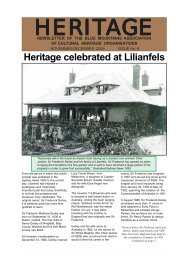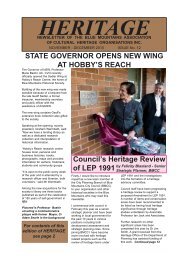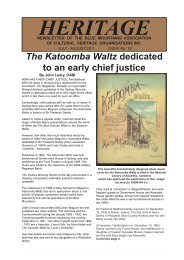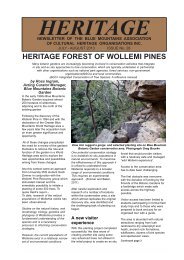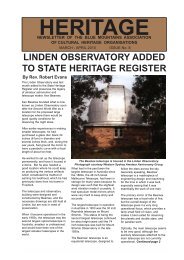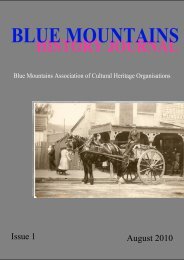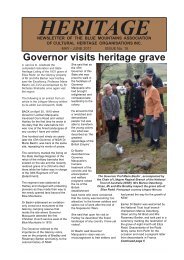Newsletter No - Blue Mountains Association of Cultural Heritage ...
Newsletter No - Blue Mountains Association of Cultural Heritage ...
Newsletter No - Blue Mountains Association of Cultural Heritage ...
Create successful ePaper yourself
Turn your PDF publications into a flip-book with our unique Google optimized e-Paper software.
Mudgee Colonial Inn Museum a part <strong>of</strong><br />
the town’s heritage<br />
THERE are few historical societies<br />
in Australia which can claim to<br />
ownership <strong>of</strong> part <strong>of</strong> a town’s rich<br />
heritage.<br />
by John Broadley --- president Mudgee Historical Society<br />
The site <strong>of</strong> the Colonial Inn<br />
Museum, headquarters <strong>of</strong> the<br />
Mudgee Historical Society, is<br />
situated on part <strong>of</strong> one <strong>of</strong> Mudgee’s<br />
most historic land grants: Portion<br />
181 <strong>of</strong> the Parish <strong>of</strong> Mudgee in the<br />
County <strong>of</strong> Wellington, a crown grant<br />
<strong>of</strong> 995 acres which was registered<br />
in 1835 to Mudgee pioneer, George<br />
Cox.<br />
Although the site contains<br />
numerous buildings from various<br />
periods, the main museum building<br />
dates from the mid 1850s and is<br />
one <strong>of</strong> Mudgee’s oldest.<br />
A recent photograph <strong>of</strong> the Colonial Inn Museum<br />
George Cox and his younger<br />
brother Henry, sons <strong>of</strong> noted<br />
Hawkesbury settler and <strong>Blue</strong><br />
<strong>Mountains</strong> road builder, William<br />
Cox, were pioneer settlers <strong>of</strong><br />
Mudgee, establishing runs at<br />
Mudgee in February 1822.<br />
They gradually accrued extensive<br />
landholdings on the southern banks<br />
<strong>of</strong> the Cudgegong River which flows<br />
through the Mudgee valley, while<br />
<strong>Blue</strong> <strong>Mountains</strong> explorer Lieutenant<br />
William Lawson occupied the<br />
northern bank.<br />
These three men were soon joined<br />
by Richard Rouse senior <strong>of</strong><br />
Windsor, Robert Lowe <strong>of</strong> Bringelly<br />
and William Bowman <strong>of</strong> Windsor as<br />
pioneer settlers <strong>of</strong> the Mudgee<br />
district.<br />
All were, however, largely absentee<br />
landowners, leaving their Mudgee<br />
lands in the charge <strong>of</strong> convict<br />
overseers until the next generation<br />
came <strong>of</strong> age.<br />
As a result <strong>of</strong> the discovery <strong>of</strong> gold<br />
in 1851 at Louisa Creek, now<br />
Hargraves, near Mudgee, the<br />
population <strong>of</strong> the district increased<br />
dramatically, and the sleepy<br />
backwater village <strong>of</strong> Mudgee<br />
became a service centre for the<br />
surrounding goldfields.<br />
Industry developed – breweries,<br />
tanneries, foundries, flour mills -<br />
while many shops and hotels were<br />
built; remarkably, many buildings<br />
from this era remain, although most<br />
have undergone transformations.<br />
From the early 1850s George Cox<br />
began to subdivide the southeastern<br />
corner <strong>of</strong> Portion 181 which<br />
adjoined the western boundary <strong>of</strong><br />
the town <strong>of</strong> Mudgee which had been<br />
proclaimed in 1838.<br />
These subdivisions varied in size,<br />
but mostly comprised a few acres<br />
and were located along, or close to,<br />
Market Lane, the north-western<br />
entry to the town.<br />
This area rapidly became a busy<br />
industrial and commercial centre to<br />
service the passing hordes on their<br />
way to and from the gold fields.<br />
Numerous shops, a soap factory, a<br />
foundry, a flour mill, wheelwrights<br />
and coach factories sprang up in<br />
the vicinity.<br />
Several hotels were erected during<br />
the 1850s between the bend in what<br />
is now known as Market Street west<br />
and the site <strong>of</strong> Radio 2MG on<br />
Mudgee’s north-western outskirts.<br />
In 1853 George Cox sold a parcel <strong>of</strong><br />
8 acres <strong>of</strong> his grant to John Brooks<br />
for £5. This was a narrow portion <strong>of</strong><br />
land on the northern side <strong>of</strong> Market<br />
Lane immediately adjacent to the<br />
town boundary and ran down to the<br />
Cudgegong River.<br />
By 1856 John Brooks had<br />
constructed the existing building –<br />
in brick, two-storeyed, with a narrow<br />
cantilevered balcony on the front<br />
facade and two rear service wings -<br />
whose design suggests that it was<br />
intended for use as licensed<br />
premises.<br />
The building was decidedly grander<br />
than many <strong>of</strong> the inns and hotels <strong>of</strong><br />
the period outside <strong>of</strong> the town<br />
boundary.<br />
On the ground floor the building’s<br />
two front doors accessed the public<br />
bar on the right and the ladies’<br />
saloon or parlour on the left.<br />
Segregated service <strong>of</strong> alcohol<br />
remained the norm until well into<br />
the twentieth century.<br />
In 1857 John Brooks sold the<br />
property to George McQuiggan,<br />
who operated a hotel on the<br />
premises until 1861.<br />
George McQuiggan was a<br />
prominent businessman with an<br />
extensive real estate portfolio in the<br />
burgeoning town.<br />
Continued page 9<br />
HERITAGE 8<br />
<strong>No</strong>vember - December 2012




